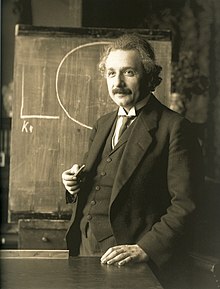| Albert Einstein | |
|---|---|
 Albert Einstein in 1921 |
|
| Born | 14 March 1879 Ulm, Kingdom of Württemberg, German Empire |
| Died | 18 April 1955 (aged 76) Princeton, New Jersey, United States |
| Residence | Germany, Italy, Switzerland, Austria, Belgium, United Kingdom, United States |
| Citizenship |
|
| Fields | Physics |
| Institutions | |
| Alma mater | |
| Doctoral advisor | Alfred Kleiner |
| Other academic advisors | Heinrich Friedrich Weber |
| Notable students | |
| Known for | |
| Notable awards |
|
| Spouse | Mileva Marić (1903–1919) Elsa Löwenthal (1919–1936) |
| Signature |
|
Albert Einstein (pron.: /ˈælbərt ˈaɪnstaɪn/; German: [ˈalbɐt ˈaɪnʃtaɪn] (![]() listen); 14 March 1879 – 18 April 1955) was a German-born theoretical physicist who developed the general theory of relativity, one of the two pillars of modern physics (alongside quantum mechanics).[2][3] While best known for his mass–energy equivalence formula E = mc2 (which has been dubbed "the world's most famous equation"),[4] he received the 1921Nobel Prize in Physics "for his services to theoretical physics, and especially for his discovery of the law of the photoelectric effect".[5] The latter was pivotal in establishing quantum theory.
listen); 14 March 1879 – 18 April 1955) was a German-born theoretical physicist who developed the general theory of relativity, one of the two pillars of modern physics (alongside quantum mechanics).[2][3] While best known for his mass–energy equivalence formula E = mc2 (which has been dubbed "the world's most famous equation"),[4] he received the 1921Nobel Prize in Physics "for his services to theoretical physics, and especially for his discovery of the law of the photoelectric effect".[5] The latter was pivotal in establishing quantum theory.
Near the beginning of his career, Einstein thought that Newtonian mechanics was no longer enough to reconcile the laws of classical mechanicswith the laws of the electromagnetic field. This led to the development of his special theory of relativity. He realized, however, that the principle of relativity could also be extended to gravitational fields, and with his subsequent theory of gravitation in 1916, he published a paper on the general theory of relativity. He continued to deal with problems of statistical mechanics and quantum theory, which led to his explanations of particle theoryand the motion of molecules. He also investigated the thermal properties of light which laid the foundation of the photon theory of light. In 1917, Einstein applied the general theory of relativity to model the structure of the universe as a whole.[6]
He was visiting the United States when Adolf Hitler came to power in 1933, and did not go back to Germany, where he had been a professor at theBerlin Academy of Sciences. He settled in the U.S., becoming a citizen in 1940.[7] On the eve of World War II, he helped alert President Franklin D. Roosevelt that Germany might be developing an atomic weapon, and recommended that the U.S. begin similar research; this eventually led to what would become the Manhattan Project. Einstein was in support of defending the Allied forces, but largely denounced using the new discovery ofnuclear fission as a weapon. Later, with the British philosopher Bertrand Russell, Einstein signed the Russell–Einstein Manifesto, which highlighted the danger of nuclear weapons. Einstein was affiliated with the Institute for Advanced Study in Princeton, New Jersey, until his death in 1955.
Einstein published more than 300 scientific papers along with over 150 non-scientific works.[6][8] His great intellectual achievements and originality have made the word "Einstein" synonymous with genius.[9]

